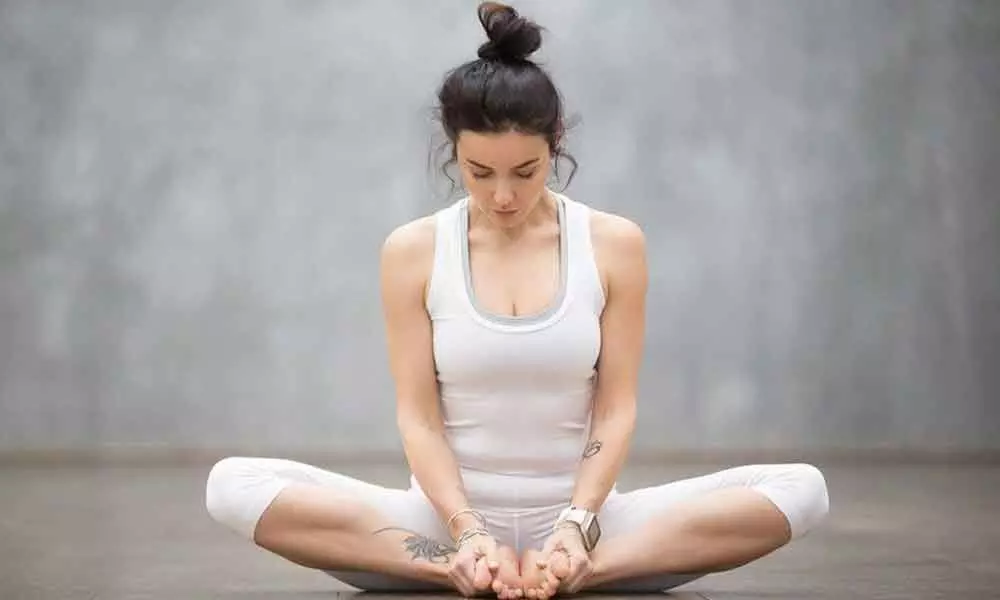Soothing yoga sequence to ease menstrual discomfort

There are specific yoga poses that can widen the pelvic opening reducing any congestion. You can make the days of your monthly cycle as cramp-free as possible by including some light yoga practice into your routine
There are specific yoga poses that can widen the pelvic opening reducing any congestion. You can make the days of your monthly cycle as cramp-free as possible by including some light yoga practice into your routine. Even a few slow yoga moves, gentle stretching coupled with some deep breathing, and Om chanting will prove to be most beneficial.
This will also be useful in balancing emotions that may otherwise cause irritability, mood swings, depression, anxiety or anger. Exercise caution however as certain asanas are specially forbidden to women during the time of menstruation. These are postures that include inverting the body, and should to be avoided during as they can cause increased bleeding and vascular congestion.
Please avoid the following asanas during your menstrual cycle:
Shirshasana
Sarvangasana
Dhanurasana
Halasana
Karnapeedasana
Bakasana
Yoga helps you improve your physical fitness levels and keeps you cramp-free during your periods. Recommended asanas such as the following can be practised to improve your menstrual health without stressing your system.
Balasana (Child's Pose)
Formation of the posture
Kneel down on mat and sit on your heels
Inhale and raise arms above head
Exhale and bend your upper body forward
Place your forehead on the floor
Pelvis should rest on the heels
Ensure that your back is not hunched
Benefits
Helps relieve fatigue. This is a resting pose to relax the body
The regulated breathing restores a state of calm
The pose lengthens and stretches out the spine
It also gently stretches the ankles, hips and shoulders
Stimulates digestion
By stretching the spine, it eases neck and back pain
Dandasana (Staff Pose)
Formation of the posture
Sit down on the ground and begin with Sukhasana
Ensure that your back is erect
Stretch your legs out in front of you. Your legs must be parallel to each other, and toes should be pointed upwards
Tighten the muscles of your pelvis, thighs and calves
Align your head in such a way that the crown faces the ceiling and the focus of your gaze is forward. This will automatically straighten and lengthen your spine
Place your palms beside your hips on the floor. This will support your spine and also relax your shoulders.
Hold the asana for a while
Benefits
This asana helps to strengthen the muscles on your back
It also helps to stretch the chest and the shoulders
Improves your posture
It stretches out the muscles of the lower body
The abdomen is stretched and strengthened as well
It is known to cure sciatica and asthma
This asana helps to focus and calm the mind. When paired with proper breathing, it relieves stress and helps enhance concentration
Baddha Konasana
(Bound Angle Pose)
Formation of the posture
Begin by assuming Dandasana
Fold your legs and bring the soles of your feet together
Pull your heels closer to your pelvis
Gently push your knees down
Empty air from your stomach, lean your upper body forward and place your forehead on the floor
Benefits
Makes hip flexors flexible
Strengthens pelvic region
Mobilizes the knee caps
Paschimottanasana (Seated FORWARD BENDING)
Formation of the posture
Begin with Dandasana
Ensure that your knees are slightly bent while your legs are stretched out forward
Extend your arms upward and keep your spine erect
Exhale and empty your stomach of air
With the exhale, bend forward at the hip and place your upper body on your lower body
Lower your arms and grip your big toes with your fingers
Try to touch your knees with your nose
Hold the asana for a while
Benefits
It acts as a stress reliever
Reduces fatty deposits in the abdomen
Removes anxiety, anger and irritability
Calms the mind
Stretches the spine and brings flexibility
Good for constipation and digestive disorder
Useful for increasing height in young practitioners by stretching of the spine
Tones the abdominal pelvic organs
Balance the menstrual cycles
This asana is recommended especially for women after delivery
During your monthly cycle, make sure that the days are allotted to the body's rest, rejuvenation and recovery. While high-impact workouts can be avoided and instead gentle stretching, pranayama and meditation can be practised. Following these simple asanas will bring long-term physical and mental benefits to the women practitioners. Try to remain free from stress and consume plenty of water to keep yourself hydrated.
( The writer is a philanthropist, spiritual master, lifestyle coach, yoga-preneur and author)
















